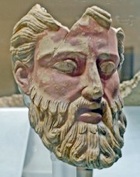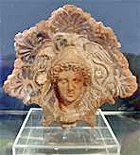

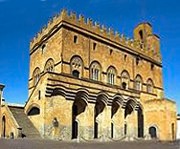
A political organisation known as the Popolo existed in Orvieto from at least 1244, and the first Capitano del Popolo was appointed in 1250. The power of this organisation waned from the late 1260s but it recovered in 1281-4, when it formed a focus for the anti-French feeling that was aroused in the city by the presence of the court of Pope Martin IV.
Ranieri della Greca, who was Capitano del Popolo in 1280-1, was behind this resurgence of the Popolo, despite the fact that his first term of office lasted for only a few months. Martin IV insisted that he should resign in 1281 after he had refused to intervene in an anti-French riot. His re-election in 1284 caused Martin V to leave Orvieto as a sign of his disgust. However, his subsequent attempt to raise a Ghibelline revolt failed and he was driven once more from the city.
The power of the Popolo survived, but it was from this point the Capitano del Popolo (if and when one was appointed) worked alongside a committee of guild representatives. This arrangement was formalised in 1292, when the leaders of the seven most important guilds formed a magistracy known as the Signori Sette. They originally met in the Palazzo del Popolo, but acquired their own premises (later the Palazzo dei Sette) in 1319.
The papal vicars occupied Palazzo del Popolo in 1398-1408 and a series of "foreign" Podestà resided here thereafter.
Stages of Construction
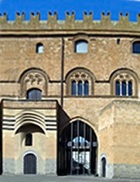
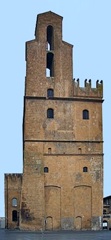
In 1281, Ranieri della Greca ordered order the building of the Palazzo del Popolo and the clearing of the piazza in front of it. The original “palace” was in fact an open loggia that provided a thoroughfare between the the new piazza and the existing Campo Santa Croce behind it. The loggia was used as a market place and for public meetings, and the Capitano del Popolo would address the citizens from the terrace above.
The spacious meeting hall on the upper storey, which is lit by a series of lovely trifore windows, must have been added soon after the loggia had been completed. The upper room and the terrace of the loggia were reached by steps at the back of the palace until the present flight of steps to the left was built in 1301. The loggia was enclosed at this point and the building was extended by two bays to the right in order to provide accommodation for the Capitano del Popolo. The so-called Arco della Pesa under the new extension now provided the thoroughfare between the Piazza del Popolo and Campo Santa Croce.
The palace was completed in 1315-6, when Poncello Orsini, the Capitano del Popolo. built the bell tower and installed a bell that was inscribed with the symbols of the 25 guilds that had paid for it. (This bell was moved to the Torre del Moro in 1876.)
When the ceiling of the meeting room threatened to collapse in ca. 1480, the opportunity was taken to to divided this room into two and to install an attic above. The larger of these new rooms corresponds approximately to the room known today as the Sala dei Quattrocento. (The Ghibelline battlements date the late 19th century restoration).
Sala dei Quattrocento
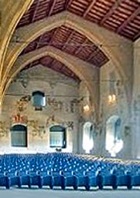
Frescoes on the West Wall
These include:
-
✴the Crucifixion (mid 14th century);
-
✴St John the Baptist (late 14th century); and
-
✴the arms of:
-
•Verrocchio di Giorgio dei Panalfini di Orte (Papal Vicar in1400);
-
•Pietro di Spoleto dei Conti di Campello (Papal Vicar and Podestà in 1401); and
-
•Andrea di Benedetto degli Avvocati di Tivoli (Podestà in 1423).
Frescoes on the North Wall
These include:
-
✴the arms of Giangiorgio dei Tiberti di Monteleone (Podestà in 1422);
-
✴other arms, including those of the Colonna and Monaldeschi families; and
-
✴a fragment of a Madonna and Child (late 15th century).
Later History of the Palace
Changes in the political structure of the city meant that some of the space in the palace became redundant from the middle of the 15th century.
-
✴The ground floor of the palace housed the Monte di Pietà from 1463.
-
✴A programme of restoration was carried out in 1557-64. Raffaello da Montelupo is documented in relation to this work in 1564, and it seems likely that he supervised the programme over the whole period.
-
✴The Padri della Dottrina Cristiana, who had acquired the nearby church of San Bernardo in 1588, subsequently established a studium on the ground floor. Students of law, theology and logic came here to study twice a day, summoned by the palace bell. This school operated until some time after 1621, when it was superseded by the college that the Jesuits established at Palazzo Sforza Monaldeschi della Cervara (which moved with them to SS Apostoli in 1625).
-
✴The Monte Frumentario moved to premises on the ground floor in 1651.
-
✴The larger of the two upper rooms of the palace housed a theatre from 1578. Queen Christina of Sweden was named as "protector of the theatre" (which was by that time called "La Fenice") when she visited Orvieto in 1680.
The present appearance of the palace, which recaptures many original features, was achieved in a further restoration in 1984-9, during which the palace was adapted to form a space for exhibitions and seminars.
Recent Excavation
The excavations of the site made in 1984-9 uncovered part a reservoir and aqueduct (13th or 14th century) under the building.
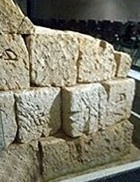
Architectural Terracottas
A number of architectural terracotta antefixes that were found in 1912 in a well in Via San Leonardo (see Walk III) might have come from this temple. They include:
-
✴two hollow terracotta heads (ca. 400 BC) of a bearded man in the Museo Archeologico, Orvieto, which probably represent Tinia/Zeus and which might have been modelled on Phidias' famous statue of Zeus (437 BC) at Olympia; and
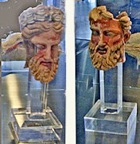
The excavations under Palazzo del Popolo in 1987-9 uncovered further terracottas from the temple. There include:
-
✴[perhaps ??] fragments of two polychrome antefixes (4th century BC) in the Museo Archeologico, Perugia.

